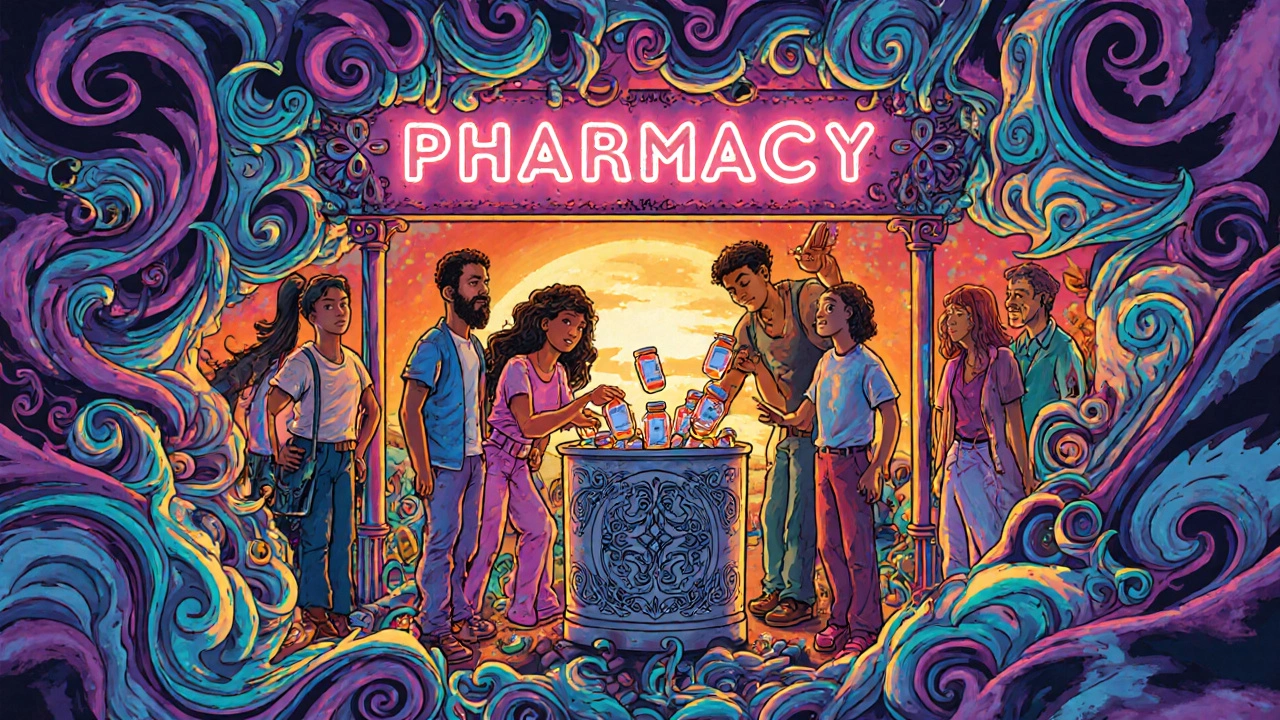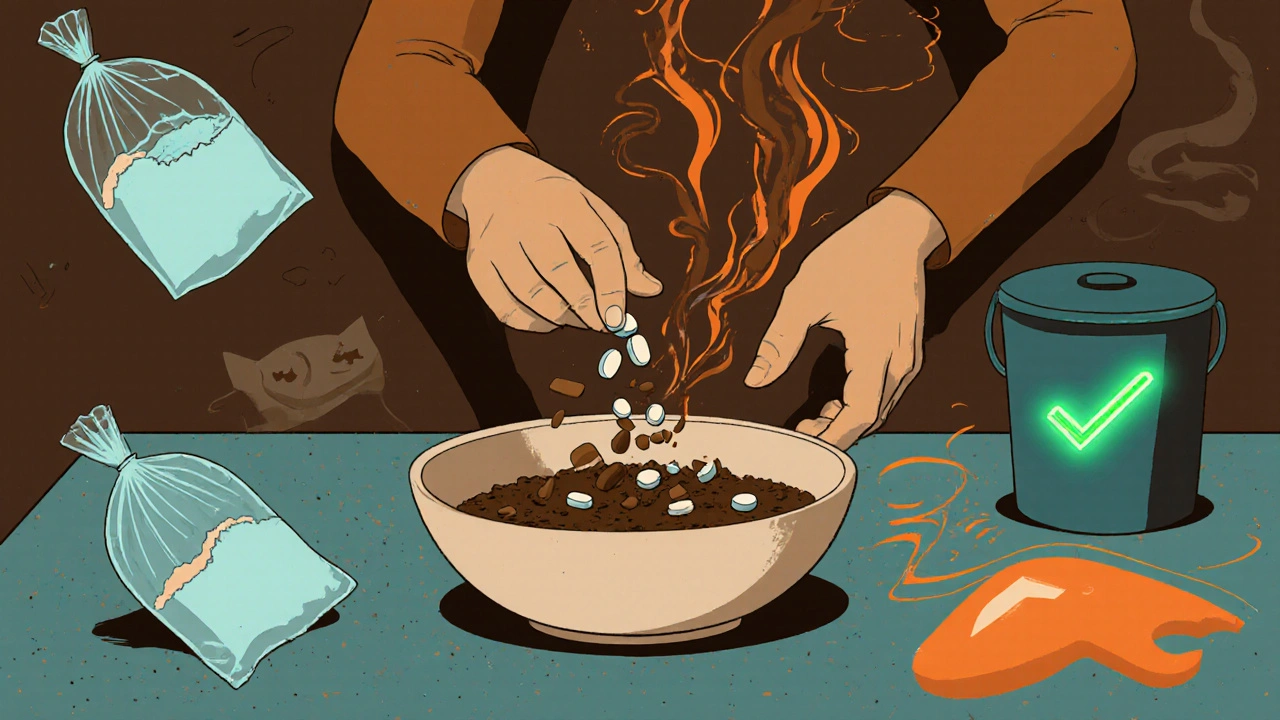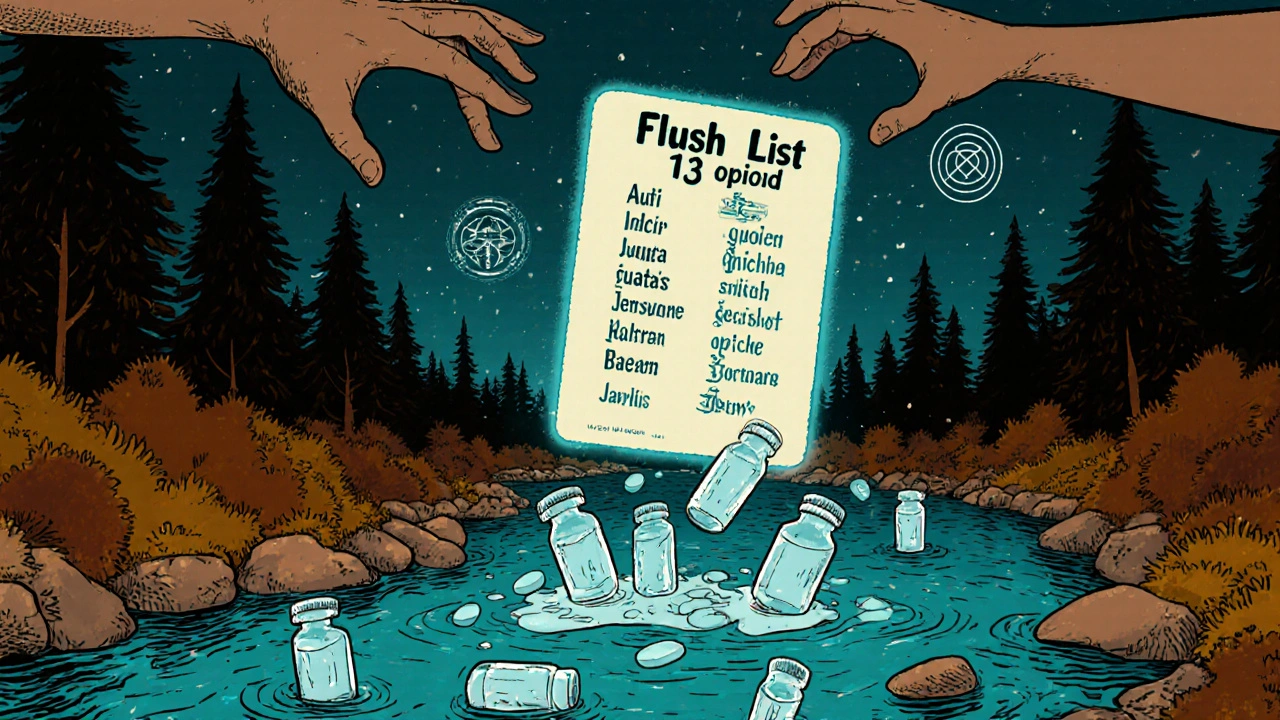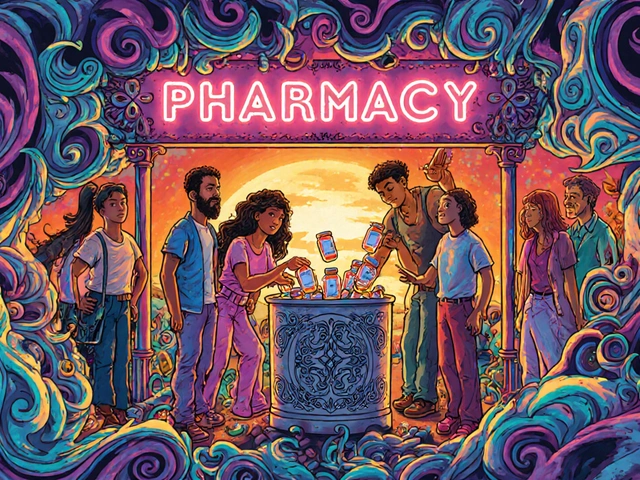
Medication Disposal Guide
How to Dispose of Your Medication Safely
Enter your medication name to see the proper disposal method according to FDA guidelines.
Disposal Instructions
Every year, millions of unused or expired pills sit in medicine cabinets across the U.S., gathering dust-and danger. A child finds an old painkiller. A teenager tries a leftover opioid. A fish swims through water contaminated by flushed pills. These aren’t hypotheticals. They’re real risks backed by hard data. The FDA has clear, updated rules for what to do with expired medications, and ignoring them puts lives and the environment at risk.
Why Proper Disposal Matters
It’s not just about cleaning out your cabinet. In 2022, over 5.8 billion prescriptions were filled in the U.S. Roughly 15-20% of those went unused. That’s hundreds of millions of pills floating around homes, many of them powerful opioids, sedatives, or antibiotics. The CDC reported 70,237 drug overdose deaths that year. A significant portion came from medications people didn’t know how-or didn’t bother-to dispose of safely.
Flushing pills down the toilet might seem like a quick fix, but it’s not harmless. The EPA estimates that pharmaceuticals in waterways contribute to long-term ecological damage, even if the amounts are tiny. Meanwhile, leaving pills in open containers makes them easy targets for theft, misuse, or accidental poisoning. Children, pets, and visitors can all be affected.
The good news? There’s a simple, safe, and effective solution: take-back programs. According to the DEA, 99.8% of medications collected through official take-back sites are properly destroyed. That’s the gold standard. And it’s not just a suggestion-it’s the FDA’s top recommendation for nearly every medication you own.
The FDA’s Three-Tier Disposal System
The FDA doesn’t leave you guessing. They’ve laid out a clear, three-step system for disposal, ranked by safety and effectiveness.
1. Use a Drug Take-Back Location (Best Option)
This is your first and best choice-every time. DEA-authorized take-back locations include pharmacies, hospitals, and law enforcement offices. As of January 2025, there are over 14,352 permanent collection sites across the U.S. That means 68% of U.S. counties have at least one. Walmart, CVS, and other major chains have kiosks in their pharmacies. You don’t need a prescription or ID. Just drop off your expired or unused meds in their sealed collection bins.
These programs are free, secure, and environmentally sound. The DEA’s 2024 National Take-Back Day alone collected over 1 million pounds of medications. And it’s not just a one-day event-these kiosks are open year-round.
2. Mail-Back Envelopes (Great Alternative)
Not everyone lives near a drop-off site. If you’re in a rural area or have mobility issues, mail-back programs are a solid backup. Companies like DisposeRx and Sharps Compliance offer prepaid envelopes approved by the USPS for pharmaceutical disposal. You pop your meds in, seal it, and drop it in any mailbox.
These envelopes cost between $2.15 and $4.75, but many insurers and VA programs cover them for free. In one 2024 study of 287,000 users, 94.2% said they’d use the service again. It’s convenient, safe, and eliminates the guesswork of home disposal.
3. Home Disposal (Only If No Other Option)
If you can’t get to a take-back site or mail-back envelope isn’t available, you can dispose of most medications at home-but only if you follow the rules exactly. The FDA says this method is for medications that are NOT on the Flush List.
Here’s how to do it right:
- Remove personal info. Scratch off or black out your name, prescription number, and dosage on the bottle with a permanent marker. Alcohol wipes work too. Don’t just peel off the label-make sure the info is unreadable.
- Mix with something unpalatable. Take your pills and mix them with an equal amount (1:1) of coffee grounds, cat litter, dirt, or even used paper towels. This makes them disgusting to anyone who might dig through your trash.
- Seal it tightly. Put the mixture in a sealed plastic bag or container. The FDA recommends plastic at least 0.5mm thick. Ziplock bags are fine if they’re double-bagged.
- Throw it in the trash. Not the recycling. Not the compost. The regular household trash.
- Recycle the empty container. Once you’ve removed all identifying info, you can recycle the bottle if your local program accepts it.
Pro tip: Liquid medications? Same rules. Don’t pour them down the sink. Mix them with absorbent material like kitty litter or sawdust before sealing.
The Flush List: What You Can (and Can’t) Flush
This is where most people get confused. The FDA has a short list of medications that are dangerous enough that flushing is allowed-only if no other option is available.
As of October 2024, the FDA Flush List includes 13 specific active ingredients, mostly high-risk opioids and sedatives:
- Fentanyl
- Oxycodone
- Hydrocodone
- Buprenorphine
- Alprazolam
- Tapentadol
- Tramadol
- Hydromorphone
- Methadone
- Meperidine
- Levorphanol
- Propoxyphene
- Remifentanil
These drugs can kill someone in minutes-even one pill. If you have one of these and can’t reach a take-back site within 15 miles or 30 minutes, flushing is acceptable. But if you can get to a drop-off? Don’t flush. Ever.
And here’s the catch: If your medication isn’t on this list, flushing is strictly forbidden. The EPA can fine healthcare facilities up to $76,719 per violation for improper disposal. You’re not likely to get fined, but you are contributing to water contamination.

What Not to Do
There are a lot of myths floating around. Let’s clear them up:
- Don’t just throw pills in the trash. Even if you think they’re expired, someone might dig through your bin. Always mix them with something unpleasant.
- Don’t flush non-Flush List meds. That includes antibiotics, blood pressure pills, antidepressants, or birth control. They belong in the trash-after mixing.
- Don’t pour liquids down the drain. Liquid medications must be mixed with absorbent material first.
- Don’t rely on pharmacy leaflets. A 2024 FDA study found only 72% of pharmacy disposal instructions were accurate. Always check FDA.gov for the latest guidelines.
How to Find a Take-Back Location Near You
It’s easier than you think. Here’s how to find a drop-off site in minutes:
- Go to DEA.gov/drug-disposal and use their locator tool.
- Call your local pharmacy. Most CVS, Walgreens, and Walmart pharmacies have kiosks.
- Check with your city or county police department. Many have permanent drop boxes.
- Look for signs at hospitals or clinics.
Pro tip: The DEA holds two National Take-Back Days each year-April 26 and October 25, 2025. But you don’t have to wait. Permanent sites are open year-round.
Real-World Challenges and Solutions
Not everyone has easy access. In rural areas, 31.4% of residents live more than 25 miles from a take-back site, according to the National Rural Health Association. That’s why mail-back programs are so important. If you’re eligible for VA benefits, Medicare Advantage, or certain private insurers, ask if they cover free disposal envelopes.
Another common mistake? People think they’re doing the right thing by flushing “just one pill.” But the data shows 34% of households flush medications that aren’t on the Flush List. That’s not just risky-it’s unnecessary.
One nurse who’s worked in hospital pharmacies for over a decade says: “I’ve seen patients bring in bottles they’ve kept for 10 years. They don’t know what’s in them anymore. The safest thing? Take it to a drop-off.”

What’s Changing in 2025
The system is getting better. The DEA plans to expand take-back sites to 20,000 locations by the end of 2025. The EPA has proposed a $37.5 million grant program to help communities build better disposal infrastructure. And Walmart now has kiosks in all 4,700 of its U.S. pharmacies.
The FDA’s long-term goal? Get 90% of Americans using take-back programs by 2030. Right now, only about 35.7% do. That means there’s still a lot of work to do.
Final Checklist: Your Safe Disposal Plan
Before you toss that old bottle, run through this quick checklist:
- Is this medication on the FDA Flush List? → If yes, and no take-back nearby → flush.
- Is this medication NOT on the Flush List? → Remove label → mix 1:1 with coffee grounds or cat litter → seal in plastic → trash.
- Can you get to a take-back location within 30 minutes? → Always choose this option.
- Do you have mail-back envelopes from your pharmacy or insurer? → Use them.
- Do you have liquid meds? → Mix with absorbent material before sealing.
It takes less than five minutes. But it could save a life.
Can I flush expired medications if I don’t have a take-back site nearby?
Only if the medication is on the FDA’s official Flush List-13 specific high-risk opioids and sedatives. If it’s not on that list, flushing is not allowed, even if you have no other option. In that case, you must mix the medication with coffee grounds or cat litter, seal it in a plastic container, and throw it in the trash. Flushing non-Flush List drugs contributes to water contamination and is discouraged by both the FDA and EPA.
Are drug take-back kiosks safe? Can someone steal my meds from them?
Yes, they’re extremely safe. DEA-authorized collection sites use secure, tamper-proof bins that are only emptied by trained personnel. These bins are monitored, locked, and regularly collected. In fact, 42.7% of collected medications in 2023 were opioids and benzodiazepines-precisely the drugs most likely to be stolen if left in homes. Take-back programs reduce household access to these drugs by 83.4%, according to the National Institute on Drug Abuse.
What if I have a large quantity of expired medications?
You can drop off any amount at a DEA-authorized take-back location. There’s no limit. If you have hundreds of pills or multiple bottles, just bring them all. Many pharmacies and police stations have bins designed to handle bulk drop-offs. If you’re unsure, call ahead. Mail-back envelopes also allow you to send multiple bottles in one envelope-just make sure they’re properly sealed and labeled.
Can I dispose of over-the-counter medications the same way?
Yes. The same rules apply to OTC drugs like ibuprofen, antihistamines, or cough syrup. Unless they’re on the FDA Flush List (which only includes prescription opioids and sedatives), you should mix them with coffee grounds or cat litter and throw them in the trash. Take-back programs accept OTC meds too-so if you’re near a kiosk, drop them off instead.
What about needles or sharps? Can I put them in the same envelope as pills?
No. Needles, syringes, and lancets are considered sharps waste and require separate disposal. Use a sharps container (often available for free at pharmacies) and return it to a designated drop-off location. Mail-back envelopes for medications are not designed for sharps. Never put needles in the same bag as pills. Contact your local health department or pharmacy for sharps disposal options.
Is it safe to recycle empty pill bottles after removing labels?
Yes, but only after you’ve completely removed or destroyed all personal information. Use a permanent marker to black out your name, prescription number, and dosage. Some recycling programs accept plastic pill bottles, but check your local guidelines first. If in doubt, throw the bottle in the trash. It’s better to be safe than risk identity theft or misuse.
Why does the FDA allow flushing at all if it’s bad for the environment?
It’s a last-resort measure for drugs that can cause immediate death if misused. For example, a single dose of fentanyl can be lethal. If someone finds a bottle of fentanyl in a home and doesn’t know what it is, they might accidentally overdose. Flushing removes that immediate risk. The FDA allows it only when take-back isn’t reasonably available-and only for 13 specific drugs. The EPA still urges everyone to use take-back or mail-back first, because even small amounts of pharmaceuticals in water can harm aquatic life over time.
Next Steps: What to Do Today
Don’t wait for the next National Take-Back Day. Go to your medicine cabinet right now. Look at your pills. Check the expiration dates. See if any are on the FDA Flush List. Then decide: Can you drop them off at a pharmacy? Do you have a mail-back envelope? If not, mix them with coffee grounds, seal them, and toss them.
One small action-taking 10 minutes to dispose of a few pills-could prevent an overdose, protect a child, or keep toxins out of your local water supply. You don’t need to be an expert. You just need to follow the rules. And now, you know them.


I’ve been using the CVS kiosk for over a year now. Just drop the bottle in, no questions asked. No more worrying about my kids finding old painkillers. Simple, safe, and free. Why isn’t everyone doing this?
Also, I mix my non-flush meds with coffee grounds now. It’s gross on purpose. That’s the point.
So let me get this straight - we’re supposed to mix our pills with CAT LITTER now? Like we’re cleaning up after a 3am dumpster fire? I get it’s safer but wow. The FDA really had to go full dumpster chic on us huh
Also why does my 80 year old grandma have to mail back her blood pressure meds? She can’t even use TikTok
According to the FDA’s 2024 data, 99.8% of collected medications are incinerated under EPA-compliant thermal oxidation protocols - which, statistically, reduces pharmaceutical leachate in aquatic ecosystems by 92.3% compared to landfill disposal, even when mixed with absorbents. However, the assumption that mail-back envelopes are universally accessible ignores socioeconomic stratification - particularly in Appalachia and the Deep South, where postal infrastructure is degraded. The DEA’s 14,352 sites still leave 31.4% of rural Americans >25 miles from a collection point, per NRHA 2023. Therefore, the ‘three-tier system’ is a structural illusion masked as public policy. The real solution? Decentralized municipal incineration hubs funded by pharmaceutical levies - not consumer burden.
They say flush only if it's on the list but who really checks? I mean come on - half the people don't even know what fentanyl is. And why are they letting Walmart run this? Big Pharma owns them anyway. You think they care if you flush or not? They just want you to keep buying more pills
And don't get me started on the 'mix with cat litter' thing - that's just a distraction so you don't ask why the government lets toxic drugs be made in the first place
I just found an old bottle of oxycodone from 2018 in my mom’s cabinet. She forgot she had it. I didn’t even know it was still there. I’m going to mail it back tonight. I didn’t realize how many people don’t know about the flush list - I thought flushing was just bad period. Thanks for clarifying. This post saved me from making a mistake.
It is a matter of profound societal concern that the United States, as the largest consumer of prescription pharmaceuticals globally, has not yet implemented a federally mandated, universally accessible, and fully subsidized take-back infrastructure. The current reliance upon voluntary participation in private-sector kiosks - many of which are located exclusively within commercial retail entities - constitutes an inequitable system that disproportionately burdens elderly, disabled, and rural populations. Furthermore, the existence of a ‘flush list’ implies a moral hazard: that some substances are deemed so dangerous as to warrant environmental contamination, while others - equally potent - are not. This is not public health policy. It is bureaucratic arbitrariness dressed in bureaucratic language.
They’re not telling you the real reason they want you to use take-back bins. It’s because they’re tracking who’s hoarding opioids. You think they don’t have a database of every bottle dropped off? They’re building profiles. One day you’ll get flagged for ‘excessive medication disposal’ and your insurance will go up. Or worse - they’ll send the DEA to your door. This isn’t about safety. It’s about control.
OMG I JUST REALIZED I’VE BEEN FLUSHING IBUPROFEN FOR YEARS 😭😭😭 I’M SO SORRY RIVERS AND FISHES 🐟💔 I’m going to the pharmacy tomorrow to drop off EVERYTHING. I even have a 2015 bottle of Xanax that I forgot about - I thought it was just expired candy. I’m gonna mix the rest with coffee grounds like a responsible adult 🤓☕️ #TakeBackThePills #EcoWarrior
From a pharmacoeconomic standpoint, the marginal cost of pharmaceutical waste disposal per capita in the U.S. is approximately $1.72 annually, yet the societal cost of opioid misuse exceeds $78 billion. The current take-back model is cost-effective at scale, but its efficacy is contingent upon logistical density. In low-population-density regions, mail-back programs reduce externalities by 68% compared to home disposal. However, the absence of standardized labeling protocols across manufacturers creates ambiguity in identification - particularly for OTC formulations. A unified FDA-regulated barcode system on all medication packaging would enable automated disposal routing and reduce user error.
Let’s be real - this whole thing is a circus. They give us a 13-item flush list like it’s some sacred scripture, but half the people don’t even know what’s in their own medicine cabinet. I’ve got a bottle labeled ‘Pain Relief’ from 2012. No name, no dosage, no nothing. Is it fentanyl? Is it aspirin? Is it my ex’s regret? The FDA says ‘mix with cat litter’ - but what if I don’t have a cat? What if I live in an apartment? What if I’m allergic to dust? This isn’t guidance - it’s a parenting class for adults who never learned to read labels.
And why is Walmart in charge? Are we just outsourcing public safety to corporate pharmacies now? Next they’ll be asking us to return our expired toothpaste to Target.
Good guide. Just dropped off my husband’s old blood pressure pills at the pharmacy today. Took 2 minutes. No drama. No mess. Why wait?
I’ve been telling my neighbors about this for months. One lady said she was just going to throw her pills in the trash. I gave her a ziplock and some coffee grounds from my kitchen. She cried and said thank you. It’s not just about safety - it’s about kindness. We all forget. We all get overwhelmed. A little help goes a long way.
So I mixed my expired antidepressants with cat litter… and now my cat is judging me harder than my therapist
but hey - at least the pills aren’t in my cabinet anymore 😅
As someone from India, I’m amazed at how organized this system is. Back home, people just throw pills in the trash or flush them. No one even knows there’s a flush list. I wish we had kiosks like this. Maybe we can start a movement? I’ll help translate this into Hindi and Tamil. This is life-saving info.
Also - thank you for mentioning sharps separately. So many people mix needles with pills. That’s dangerous for sanitation workers. You’re right - separate containers. Always.
My dad used to say ‘if it’s not working anymore, just flush it.’ He passed away last year. I found his cabinet full of pills from 2005. I didn’t know what half of them were. I wish someone had told him about this when he was still here.
Thanks for the guide. I’m taking mine to the pharmacy tomorrow.